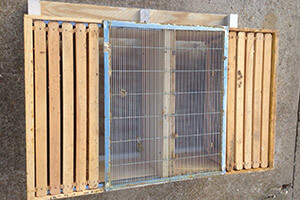
One of our readers wanted to know why I am experimenting making a new two-queen system instead of simply using the existing tried and true management scheme already incorporated for many years to have two-queen systems: a traditional hive that incorporates a double screen and an extra hive body? With this traditional two-queen system, the only special equipment you need is a double screen. Our editor, Mr. Joe Graham, speculated I might be trying to improve on that system. Actually, as the reader commented, it is a good system, it works quite well. But, the hive has some drawbacks.
As we age, we begin to think about working bees without having to move as much equipment, especially heavy equipment (think standard hive bodies full of bees and honey). Many beekeepers are changing to all medium depth hive equipment. If I were producing extracted honey, that might be my plan. I would and probably will, at some time, switch to medium depth supers (2) for brood chambers. Since comb honey production continues to haunt this beekeeper, I will probably continue to explore equipment.
The big advantage of a horizontal hive is that the beekeeper does not need to lift heavy equipment. It is easier on the back. Long hives, including the top bar hive, do not require the beekeeper to lift an entire hive of 10 or more frames full of bees and honey. Once the top of a horizontal hive is open, all frames are accessible. Keeping bees overwintered in a single deep has some difficulties, but time has made that decision for me.
For a top-bar hive, the unit could be separated into two colonies with openings on either end. This would crowd the bees somewhat if a keeper would use the current size. Dr. Wyatt Mangum has published a “standard” dimension for the top-bar hive in our American Bee Journal not too long ago. The separation would, of necessity, go from bottom to the top. Two vertical queen excluders could leave space in the middle or top supering though a horizontal excluder is better. I intend to stay with the Langstroth standard hive bodies. I must admit that using a divided top-bar hive does intrigue me.
The main reason for developing a two-queen system with a long hive body, containing two standard depth supers is to allow access to both colonies without moving a standard hive body to access the brood chambers. The colonies must have a solid, inner cover on either side of the queen excluder which spans the connecting half of each of the two brood chambers. Bees will then be able to store honey above the queen excluder from both hives. There will be a single stack of supers above the centrally located queen excluder. This system is not my invention; it has been used successfully by other beekeepers.
The tops and bottoms will be my own design. My shop work after Christmas was to design and build a bottom board for two colonies. Anyone could use …


